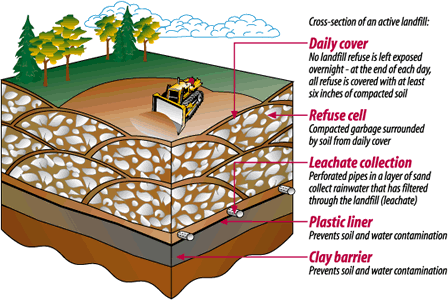What a Dump!
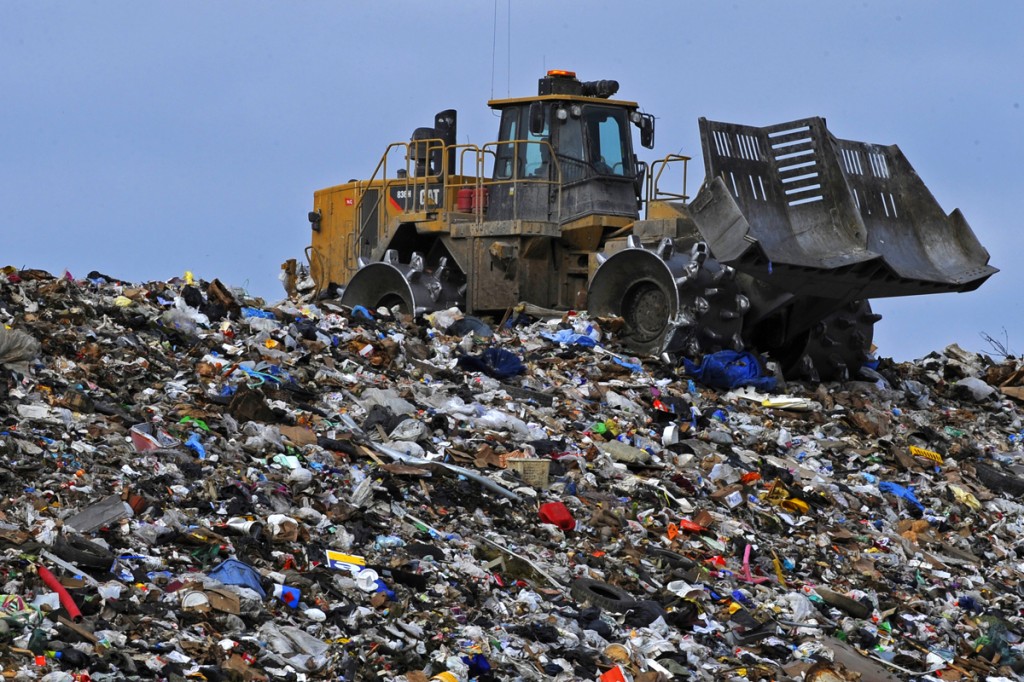
Lesson courtesy of Teachengineering.org, developed by the Integrated Teaching and Learning Program, College of Engineering, University of Colorado at Boulder.
Summary
In this activity, middle school students learn about environmental, civil, and sanitation engineering by designing and building model landfills that hold the most garbage, minimize costs, and prevent trash and contaminated “rainwater” from polluting the nearby “city.” Teams test their landfills, and graph and compare designs for capacity, cost, and performance.
Grade level: 5th – 7th (can be scaled up or down)
Time: 60 minutes
Engineering connection
Engineers design landfills to contain many types of human-generated waste. The garbage can come from household trash cans, worn-out tires, sludge from waste-water treatment plants, old couches, and scrap metal. The main challenge for engineers is to keep the waste materials from being a health hazard. Also, because of economic and environmental constraints, landfills must be as small as possible while holding the most amount of waste material possible. Engineers work with regulators to design landfills that are suitable for hazardous and non-hazardous waste.
Learning Objectives
After doing this activity, students should be able to:
- Describe a landfill and its purpose.
- Explain the alternatives to dumping human-made garbage in landfills and ways to decrease the amount of waste that ends up in landfills.
- Describe how landfills can be hazardous for the environment if they are not well engineered.
- Describe the kinds of materials make good liner systems for landfills.
- Explain what it means to “optimize” something.
Learning Standards
International Technology and Engineering Education Association
- L. Requirements are the limits to designing or making a product or system. (Grades 3 – 5)
- B. Waste must be appropriately recycled or disposed of to prevent unnecessary harm to the environment. (Grades 3 – 5)
- D. Requirements for a design include such factors as the desired elements and features of a product or system or the limits that are placed on the design. (Grades 3 – 5)
- Understand the effects of technology on the environment [K-12]
- Apply the design process [K-12]
- Assess the impact of products and systems [K-12]
Common Core State Mathematics Standards
- Solve real world problems involving division of unit fractions by non-zero whole numbers and division of whole numbers by unit fractions, e.g., by using visual fraction models and equations to represent the problem. For example, how much chocolate will each person get if 3 people share 1/2 lb of chocolate equally? [Grade 5]
- Display numerical data in plots on a number line, including dot plots, histograms, and box plots. [Grade 6]
- Develop a uniform probability model by assigning equal probability to all outcomes, and use the model to determine probabilities of events. [Grade 7]
- Understand that multiplication is extended from fractions to rational numbers by requiring that operations continue to satisfy the properties of operations, particularly the distributive property, leading to products such Interpret products of rational numbers by describing real-world contexts. [Grade 7]
- Modeling [High school]
Materials
- clear plastic tub (~12-in long × 6-in wide × 5-in deep) (~30-cm x 15-cm x 13-cm) with about 1 inch (2.54 cm) of sand in the bottom
- clay (~750 cm3), this clay does not need to be the high-quality type used for modeling; clayey or silty soil from your backyard works fine
- sand (~1500 cm3) (available at home and garden stores)
- gravel (~100 cm3) (available at home and garden stores)
- ~15 cotton balls
- (optional) tiny houses and buildings (such as Monopoly game houses and hotels), or any other simple representation to simulate the presence of a town sitting on the sand base
- Roles and Optimization Worksheet
- Budget Worksheet
- food coloring
- clear plastic tub in which to mix together food coloring, water, and cotton balls (“garbage”)
- (optional) gloves or spoon to “mix” the garbage
- strips of plastic garbage bags, to simulate geosynthetics used in landfills
- toothpicks
- straws
- popsicle sticks
- small, paper “Dixie” cups (~85 ml size), to measure and distribute clay, gravel and sand
- access to water
- watering can, water bottle, or other “rain storm” device
- (optional) electric fan, to simulate the erosion force of wind
- (optional) graph paper
Americans generate about 250 million tons of trash every year. Since about 300 million people live in the United States, that works out to about 4½ pounds of trash per person — every single day!
Before the Activity
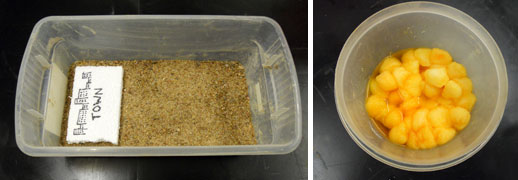
- Gather materials and make copies of the Roles and Optimization Worksheet and Budget Worksheet.
- For each group, prepare a tub with a bottom sand layer to serve as a landscape upon which to build a landfill (see photo, above left). Set up a town using small houses (or other materials) to represent a population using the groundwater (for drinking, cooking, cleaning, gardening, recreation, etc.).
- Prepare the “garbage” by mixing cotton balls, food coloring and water (see photo, above right).
With the students, design & build the landfill:
- Divide the class into groups of four students each. Hand out the Roles and Optimization Worksheets.
- Assign each group member one of four team roles (or let the students decide amongst themselves). Have them indicate on their worksheets who is responsible for each role.
- Project engineer: The project engineer is the project leader. This person is in charge of final decisions. S/he listens to all of the engineers and helps to decide the best idea. S/he makes sure the landfill gets built on schedule.
- Design engineer: The design engineer plans how the landfill will work and look. This person is in charge of picking materials and deciding how the landfill should be built. S/he works with the budget office (when picking materials) and construction engineer (when deciding how to build the landfill).
- Construction engineer: The construction engineer builds the landfill. This person gets the plans about how to build the landfill from the design engineer. If the landfill design must be fixed, s/he talks to the budget office about getting more or different materials.
- Budget office: The budget office makes sure that the project spends the least amount of money possible. This person helps the design engineer pick materials. S/he is in charge of filling out the budget worksheet, doing the calculations, and keeping track of how much money has been spent. You cannot go over budget!!
2. Introduce the project objectives to the students: Each group must design a landfill that (a) can hold the most garbage, (b) minimizes the cost, while making sure that, (c) the landfill is able to contain the waste during a rainstorm without allowing leachate to get to the town. As you do this, just like engineers, you will be following the steps of the engineering design process: understand the need, brainstorm different designs, select a design, plan, create, test, analyze and improve.
3. Hand out the budget worksheets to the “budget office” students in each group and talk with them about the different materials.
4. Have the “design engineer” students draw out his/her team’s landfill design and complete the budget worksheet.
5. Sign-off on the engineering landfill designs and budget worksheets for each group.
7. Have students bring both their approved (signed) designs and completed budgets to the “supply shop” to get their supplies.

8. Have students construct the base liner systems for their model landfills (see photo, above). The goal is to keep water from getting out of the landfill. Therefore, materials such as clay and geosynthetics are good choices, because water cannot flow through them easily. (Basically, the liner should look like a clay bowl or box. Of course, not all teams will choose this path — so you may see Popsicle sticks, toothpicks, etc., at this stage. The word “system” is used because students can use a combination of materials to make base liners [however, because of the budget constraint, they cannot afford to buy many things].) Remember to save some funds to purchase materials to build your top cap (to put on after the garbage is inserted). A landfill without a top is no good for anybody!
9. Fill the landfill with “garbage” (see photo above) making sure not to let the food coloring seep out into the area around the landfill before construction is completed. Count how many cotton balls you put in. Have the Project Engineer tell you how many to put in.
10. Have students record the quantity of garbage cotton balls that their landfills can hold on the worksheet.
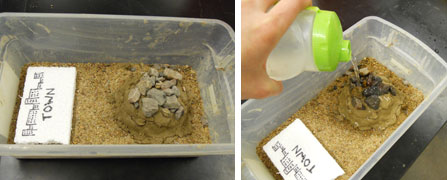
11. Give students time to finish constructing the top cap liner systems for their landfills (see photo, above). The purpose of the top cap is to keep the rain out of the landfill. Therefore, like the bottom liner system, it should be made of materials water cannot flow through. Additionally, some protection (such as gravel) can be placed on top to keep rainwater and sunlight from eroding away the liner.
Test the landfill performance:
With the Students:
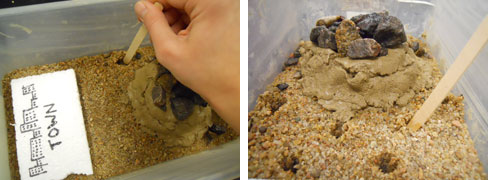
- Create “rainstorms” by pouring water on the model landfills (see photo, above).
- Use a pencil or Popsicle stick to dig into the sand outside of the landfill and near the town to look for any seeping food coloring (leachate) (see photo, above). Make multiple soils tests.
- Repeat the rainstorm, if desired.
- (optional) Apply other erosion forces to the model landfill, such as wind or earthquakes.
Activity extensions
Give students more time and different project constraints to redesign and rebuild their landfill models. For example, change the price of the materials and see how that affects the landfill designs. Or, require each landfill to hold at least a certain amount of trash (cotton balls). Or, have the class collectively make a new design that incorporates the best aspects of all the designs, as well as improvements suggested through testing.
Activity scaling
- For lower grades, give a far more specific design with more constraints. For example, only allow the use of clay. See which group can use the least amount of clay to hold the most trash. Walk the students through the activity step-by-step. Build the bottom liner as a class. Help each group to make sure they are successful.
- For upper grades, put a tracer in the “garbage” and do chemical testing of the water seeping out of the landfill. For example, one simple tracer to measure for is pH. Lemon juice has a low pH and can be measured with litmus paper. Then have students discuss how to clean up the acidic leak (such as by adding a material with a higher pH, such a baking soda).
- Vary the activity to suit the class and available supplies. Perhaps leave the material choices more open ended, and/or add the idea of removing leachate from the landfill (using straws, turkey basters, etc.). Have teams design and build the best model landfill possible.
Additional Resources
Fresh Kills Landfill article. Opened in 1947, New York City’s landfill is the biggest man-made structure on Earth.
Diagrams of how engineers have designed landfills:
Activity photos Copyright © 2010 Jean Parks, ITL Program, College of Engineering, University of Colorado at Boulder
© 2010 by Regents of the University of Colorado.
Content was developed by the Integrated Teaching and Learning Program under National Science Foundation GK-12 grant no. 0338326.
Filed under: Class Activities, Grades 6-8, Grades 6-8, Lesson Plans
Tags: build, Class Activities, Design, dump, Environmental Engineering, graph, Landfill, Mathematics, Pollution, sanitation, Trash









